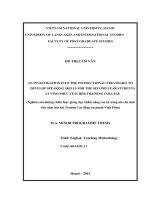Changing imperative sentences into the passive
Bạn đang xem bản rút gọn của tài liệu. Xem và tải ngay bản đầy đủ của tài liệu tại đây (8.16 KB, 1 trang )
Changing imperative sentences into the passive
An
imperative sentence
does not normally have a subject. It is used to express a command or request.
Please bring me a glass of open.
Open the door.
The imperative sentence in the passive voice takes the following form:
Let + object + be + past participle
When the active voice is in the negative, the passive voice takes the following form:
Let not + object + be + past participle
Help him. (Active Voice)
Let him be helped.
(Passive Voice)
Finish the job at once. (Active Voice)
Let the job be finished at once
. (Passive Voice)
Carry him home. (Active Voice)
Let him be carried home
. (Passive Voice)
Do not beat the dog. (Active Voice)
Let the dog not be beaten
. OR Let not the dog be beaten. (Passive Voice)
Close the window. (Active voice)
Let the window be closed
. (Passive voice)
Sometimes we want to begin the sentence with
you
so that the emphasis is on the person addressed. In such
cases, the passive voice takes the following form:
Help him. (Active Voice)
You are requested to help
him. (Passive Voice)
Don’t touch it. (Active Voice)
Let it not be touched. (Passive Voice)
You are warned
not to touch it. (Passive Voice)
Learn your lessons. (Active voice)
You are required
to learn your lessons. (Passive voice)
The passive form has to begin with
you
, when the object of the verb in the active voice is not given.
Work hard. (No object) (Active Voice)
You
are advised to work
hard. (Passive Voice)
Get out. (No object) (Active Voice)
You
are ordered to get out
. (Passive Voice)
Be first to know when grammar rules change! Sign up to our newsletter here: englishgrammar.org (It's free)
Powered by TCPDF (www.tcpdf.org)









